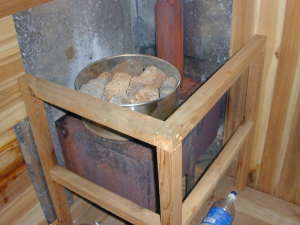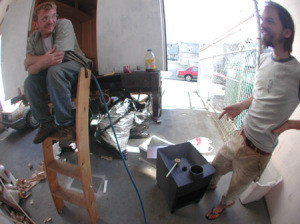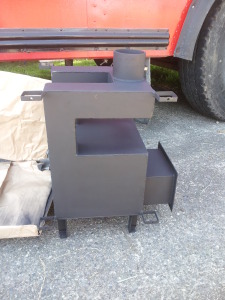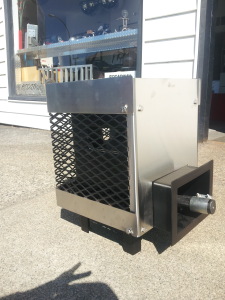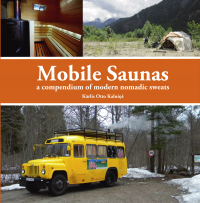We built 3 new sauna stoves this year and did some work on two original stoves, so we’ve been thinking a lot about stove design. Since we run our mobile saunas in the city where wood fires are prohibited, propane gas is our fuel of choice. It’s readily available, burns clean (no smoke in the neighbourhood), and a 20lb tank will last for about 12 hours of sauna time with no refuelling.
Our original stove design from 2000 was a steel box with an old driveshaft for a chimney, powered by a 50k btu 2-ring cast-iron banjo burner inside. We later added a stainless steel heat shield to soften the radiant heat the leg level and this essential feature considerably improved the feel of the sauna. The original burner finally rusted out completely this year, but we managed to find a used burner at the local recycling depot that’s smaller but sufficient to get the sauna as hot as we need. Our next stove built in 2005 was built with some improvements. A exhaust manifold attempts to capture more heat energy before the fumes go out the chimney. The fire box has more flame “headroom” to allow for better combustion. The stove was also originally intended to be used with gas or wood fuel, but it’s only been used for gas. As with the first stove, the heat shield was also added later. This one was improvised with corrugated aluminum. It’s definitely better than no heat shield, but stainless steel (or even painted mild steel) would be safer in the event that someone accidentally touched the hot stove. The only other similar gas stove on the market we’ve seen is the Vico Scandia Ultra Sauna heater (and used in the mobile Surf Sauna out in New Hampshire), and from what we’ve seen it’s a very nice stove. All stainless steel, 2 sizes, and automatic burner control options. It’s more expensive than we can afford, but we looked closely at their design as we began building our new stoves.Our new stove designs have a similar size but incorporate a manifold before the chimney to keep as much heat inside the sauna as possible. The stoves are made with 1/8″ steel and painted with high-heat enamel. The stainless heat shield is wrapped around and attached with brackets to the stove body. A separate door/wall interface module can be built to accommodate different burners, vehicle bodies, and installation options. When installed the stove vents through the roof or wall through a 4″ stovepipe chimney. Additional steel flashing covers the walls around the stove and chimney. As in previous designs we use a 50kbtu high-pressure cast iron propane burner; the burner must be selected with a neck length appropriate to the size of the stove. These stoves still use manual controls for lighting and flame control that we can upgrade in the future to a more automated system. The design continues to evolve with each stove. The manifold is now easier to construct, and our most recent model incorporated a new mesh shield that can be filled with additional rocks (similar to the IKI sauna heaters) so the stove body is surrounded by rocks and has an amazing stone wall appearance. We also reduced the stove size to fit better in smaller mobile saunas. In a future post we’ll cover the stove design in more detail. If you’re interested in our stove design or would like to share your stove design experiences we’d like to hear from you.


